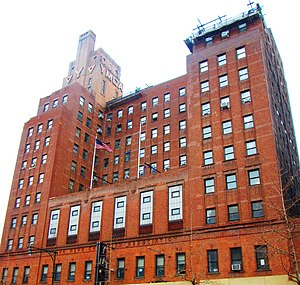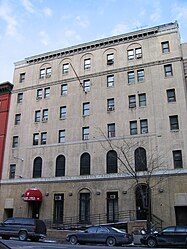Harlem YMCA
Harlem YMCA (Claude McKay Residence) | |
 (2014) | |
 Harlem YMCA  Harlem YMCA  Harlem YMCA | |
| Location | 180 West 135th Street Manhattan, New York City[1] |
|---|---|
| Coordinates | 40°48′51″N 73°56′30″W / 40.81417°N 73.94167°WCoordinates: 40°48′51″N 73°56′30″W / 40.81417°N 73.94167°W |
| Area | 9.9 acres (4.0 ha) |
| Built | 1931-32[2] |
| Architect | James C. Mackenzie Jr. (architect in charge)[3] |
| NRHP reference No. | 76002143[1] |
| Significant dates | |
| Added to NRHP | December 8, 1976[1] |
| Designated NHL | December 8, 1976[4] |
| Designated NYCL | February 10, 1998 |
The Harlem YMCA is located at 180 West 135th Street between Lenox Avenue and Adam Clayton Powell Jr. Boulevard in the Harlem neighborhood of Manhattan, New York City. Built in 1931-32, the red-brown brick building with neo-Georgian details was designed by the Architectural Bureau of the National Council of the YMCA, with James C. Mackenzie Jr. as the architect in charge.[2][3] It replaced the building from 1919 across the street.[3] Inside the building is a mural by Aaron Douglas titled "Evolution of Negro Dance." The building was declared a National Historic Landmark in 1976,[5][6] and was designated a New York City Landmark in 1998.[2]
Background[]
Around 1900, a "colored" YMCA operated at 132 W. 53rd street, in the area then known as "San Juan Hill" (now Lincoln Square), which was then a mainly African American residential neighborhood.[7] Between 1910 and 1930, Harlem developed from a mostly white neighborhood to become the center of New York's African American community. [7]
Original West 135th Street Branch (Jackie Robinson Youth Center)[]

The West 135th Street Branch YMCA, at 181 West 135th Street, was built in 1919 at a cost of $375,000, with funding from Julius Rosenwald, president of Sears, Roebuck and Company.[8][7] The 226 room building was designed by architect John Jackson in a style suggesting an Italian palazzo.[9][7] The West 135th Street Branch established itself as a major institution in the community and in the Harlem Renaissance, serving everyone from writers to Pullman porters and black youth seeking work in New York City. Before long the West 135th Street Branch was overcrowded, and more space was needed for counseling and program spaces.[7] The West 135th Street YMCA was a temporary home for many visiting African American visitors and performers to New York who were denied lodging in New York's midtown hotels because of racial discrimination.[7] These include renowned writers such as Richard Wright, Claude McKay, Ralph Ellison, Langston Hughes; artists Jacob Lawrence and Aaron Douglas; actors Ossie Davis, Ruby Dee, Cicely Tyson and Paul Robeson.[7]
In 1933, the current Harlem YMCA was built at number 180 135th street, directly across from the 135th Street Branch. By 1938, the original building at 181 was remodeled as the Harlem annex and in 1996 it became the Harlem YMCA Jackie Robinson Youth Center.[7] The 181 building received New York City landmark status in 2016.[10] By 2015, news reports indicated that the 181 building was being operated as a private apartment building operated by the Abyssinian Baptist Church.[11] The building owners owed over $620,000 in property taxes and were cited "nearly 200 times for roach and mouse infestation, broken window guards, water leaks and busted carbon monoxide detectors."[11]
History and significance[]

The Harlem YMCA, intended primarily for the use of African-American men at a time when most YMCAs were for whites only, was one of the best equipped YMCAs in the United States.[12] Its upper floors were designed for use as residences, whose occupants include a number of prominent personalities.[5]
African-American author Maria Celeste lived in the building from 1941 through 1946,[5] Bill Clinton is a current member.[13] and many notable black Americans have stayed at the facility, including Malcolm X – then Malcolm Little – who chose to stay there because of its proximity to his favorite nightclubs.[14] The building was designated a National Historic Landmark in 1976 for its association with the African-American writer Claude McKay (1889-1948), a leading figure of the Harlem Renaissance who was resident here from 1941 until 1946.[5]
See also[]
- List of New York City Designated Landmarks in Manhattan above 110th Street
- List of National Historic Landmarks in New York City
- National Register of Historic Places listings in Manhattan above 110th Street
References[]
- ^ a b c "National Register Information System". National Register of Historic Places. National Park Service. July 9, 2010.
- ^ a b c New York City Landmarks Preservation Commission; Dolkart, Andrew S.; Postal, Matthew A. (2009). Postal, Matthew A. (ed.). Guide to New York City Landmarks (4th ed.). New York: John Wiley & Sons. p. 204. ISBN 978-0-470-28963-1.
- ^ a b c White, Norval; Willensky, Elliot & Leadon, Fran (2010). AIA Guide to New York City (5th ed.). New York: Oxford University Press. p. 541. ISBN 978-0-19538-386-7.
- ^ "Claude McKay Residence". National Historic Landmark summary listing. National Park Service. September 10, 2007. Archived from the original on June 6, 2011.
- ^ a b c d ""Claude McKay Residence", by Lynne Gomez-Graves (National Register of Historic Places Inventory)" (pdf). National Park Service. n.d.
- ^ "Claude McKay Residence--Accompanying photo, exterior, from 1976 (National Register of Historic Places Inventory)" (pdf). National Park Service. n.d.
- ^ a b c d e f g h Turkel, Stanley. "Hotel History: YMCA of Greater New York". Hospitality.net. Retrieved August 23, 2020.
- ^ "Julius Rosenwald, Philanthropist" (PDF). National Park Service. National Park Service. Retrieved August 23, 2020.
- ^ Krisel, Brendan. "Harlem YMCA Gains Landmarks Designation After Decades on Backlog". Patch. Retrieved August 23, 2020.
- ^ Rosenberg, Zoe (December 14, 2016). "Landmarks moves to clear backlog with sweeping approvals". Curbed. Archived from the original on 17 October 2020. Retrieved August 23, 2020.
- ^ a b Solis, Gustavo (September 10, 2015). "Abyssinian Church Building Racks Up Fines and Overdue Taxes, Records Show". DNAInfo. Retrieved August 23, 2020.
- ^ New York Landmarks Preservation Commission plaque, 1999
- ^ Harris, Bill. One Thousand New York Buildings, Black Dog and Leventhal. 2002. ISBN 1-57912-443-7; p.374.
- ^ Perry, Bruce. Malcolm: The Life of the Man Who Changed Black America (1992)
External links[]
 Media related to Harlem YMCA at Wikimedia Commons
Media related to Harlem YMCA at Wikimedia Commons- Official website
- National Historic Landmarks in Manhattan
- Residential buildings on the National Register of Historic Places in Manhattan
- Buildings and structures completed in 1932
- New York City Designated Landmarks in Manhattan
- Harlem
- YMCA buildings in the United States

